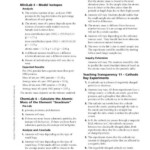Teaching Transparency Worksheet Chemistry Answers Chapter 10 – You’re here because you are looking for Chemistry Worksheet Answers. In this article, you’ll learn more about the branches of chemistry, identifying molecules, chemical reactions, and electroneutrality. In addition, you’ll discover how to find answers to questions related to solid state change.
Identifying molecular compounds
A molecular compound is a mixture of two or more elements, usually non-metals. Many compounds are made of neutral molecules and do not contain any ions. On the other hand, covalent compounds are formed when more than one element shares electrons. This is known as covalent bonding, and it will be covered in greater detail in a subsequent module. It is easier to identify molecular compounds by using their physical properties. Compounds beginning with the letter H are acidic, while those that are only made up of carbon and hydrogen are called hydrocarbons. These compounds are designated with special nomenclature. These compounds have special nomenclature. Electropositive elements are more prominent than electronegative ones. Additionally, there are more electronegative elements given -ide endings.
Names for molecular compounds should include information about the number of elements in each atom. The prefix is dropped if the molecule contains only one atom from a particular element. However, if the molecule contains two atoms from a different element, it will be prefixed. In addition, the naming convention for binary molecular compounds follows the rule of a-, which means that there are two or more atoms of a specific element.
Chemical reactions
Chemical reaction refers to the process of joining different elements or compounds to create a new one. This is also called synthesis. In this process, multiple simple substances combine under specific conditions to form a complex product. This is the result: carbon dioxide and water. Heat is required for the process of synthesis. Students should know this fact when they are working on a chemical reaction worksheet.
Every day chemical reactions occur. Many people don’t understand how chemical reactions work. Essentially, they involve the breaking of bonds between two substances. The process uses energy to form and break the bonds. The change in structure results in a different substance, but the amount of matter is the same.
Molecular nomenclature
The properties of different compounds are described using molecular nomenclature. Hydrocarbons are substances that contain carbon and hydrogen. A compound known as an alkane has a single carbon-carbon bond and the general formula CnH2n+2. Many fuels require alkanes. The term “alkane” is also used to name a substance that has a straight chain of carbon.
Chemistry worksheets include a molecule nomenclature section that covers the elements, compounds, and formulae. Some worksheets even cover the naming ionic compounds. This worksheet is a great way to start learning chemistry. You can also use it to review what you have already learned. It will allow you to remember chemical patterns and the names of compounds. It will make it easier to remember the names of the chemicals when you are in chemistry class.





